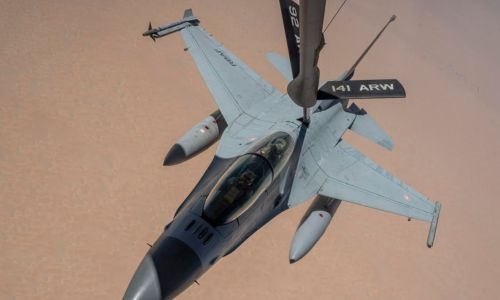The Ninth Air Force (Air Forces Central)’s 378th Air Expeditionary Wing recently conducted Ballast Cannon 24.10 alongside the Royal Bahraini Air Force in a routine exercise above the Arabian Peninsula. This exercise, which occurs nearly quarterly, aims to support the U.S. Air Force’s rapid expeditionary capabilities by integrating air-to-air training objectives between the two air forces and their operational support personnel. U.S. Air Force F-16 Fighting Falcons from Aviano Air Base’s 510th Expeditionary Fighter Squadron and a KC-135 Stratotanker from Fairchild’s 92nd Expeditionary Air Refueling Squadron were deployed to maintain rapid response to crises and eliminate aerial threats.
The bilateral training between the Royal Bahraini Air Force and the U.S. Air Force focuses on strengthening the bonds between coalition forces and building a foundation for future engagements in support of the Combined Defense of the Arabian Peninsula. The training objectives include aerial refueling, coalition command and control, and tactical integration. The U.S. Air Force’s long-standing relationships within the U.S. Central Command area of responsibility enable regular and routine training, which helps advance the coalition’s ability to become a seamless operational force across every warfighting domain.
The collaboration between the Royal Bahraini Air Force and the U.S. Air Force highlights the importance of international partnerships in maintaining security and stability in the region. These exercises not only enhance the capabilities of both air forces but also contribute to the overall readiness of coalition forces in responding to potential threats in the Arabian Peninsula. By engaging in regular training activities, both nations can ensure interoperability and readiness to effectively work together in various scenarios.
Participating in exercises like Ballast Cannon 24.10 allows the Royal Bahraini Air Force to benefit from the expertise and experience of the U.S. Air Force, while also providing an opportunity for U.S. forces to operate in a different environment and terrain. This mutual exchange of knowledge and skills strengthens the overall defense capabilities of both nations and enhances their ability to collaborate efficiently in joint operations. The training activities help foster a sense of camaraderie and trust between the personnel of both air forces, laying the groundwork for enhanced cooperation in future engagements.
The integration of air-to-air training objectives in exercises like Ballast Cannon 24.10 reflects the commitment of both the Royal Bahraini Air Force and the U.S. Air Force to enhancing their operational capabilities and readiness. By working together on key training objectives such as aerial refueling and tactical integration, both air forces can better prepare for potential real-world scenarios and improve their ability to respond effectively to emerging threats. These exercises also demonstrate the shared commitment of both nations to maintaining peace and security in the region through collaborative efforts and joint training initiatives.
In conclusion, the recent joint exercise between the Royal Bahraini Air Force and the U.S. Air Force underscores the importance of international cooperation and collaboration in strengthening defense capabilities and promoting regional security. By engaging in regular training activities and exercises, both air forces can enhance their interoperability and readiness, ultimately contributing to the overall stability of the Arabian Peninsula. The long-standing partnership between the two nations continues to grow through joint training initiatives like Ballast Cannon 24.10, laying the foundation for closer cooperation and coordination in future missions and operations.











